Game Reviews: Xenoblade Chronicles Definitive Edition, Eternights, Senran Kagura Shinovi Versus, and Unicorn Overlord
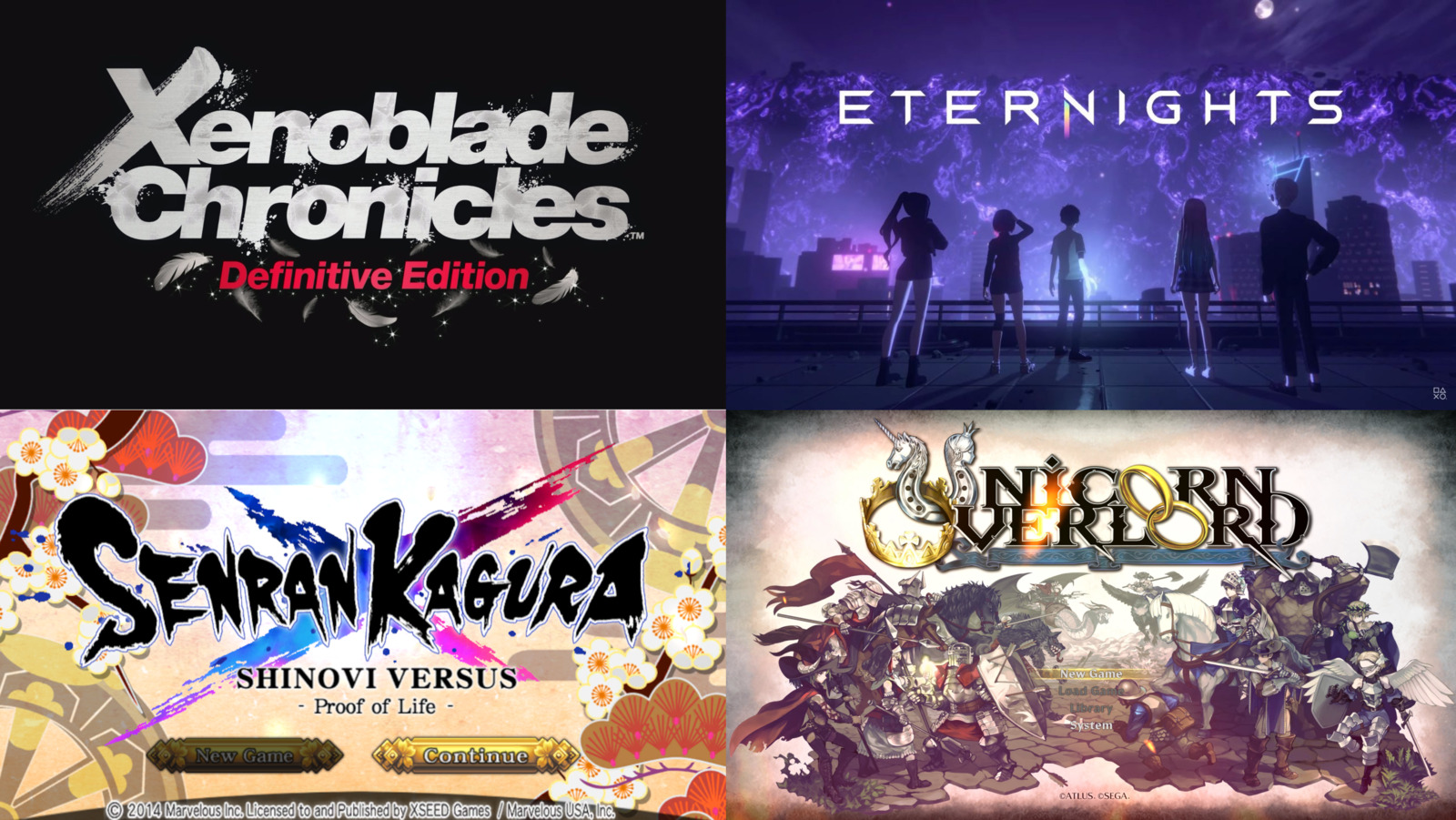
Over the winter and spring, I played a mix of fighting and role playing games on a variety of systems. Starting with the Switch, I finally got through Xenoblade Chronicles. It’s a game I’ve gotten frustrated with and put down several times due to it’s focus on grinding and terrible combat mechanics. I’m glad I finished it to experience its well written conclusion, but still found it a slog. Wanting to play a shorter title, I picked up Eternights, a brawler, horror and dating sim all mixed into a short unpolished package. It was a brief but fun interlude that held me over until the PlayStation release I was waiting for. I also picked up a refurbished PlayStation Vita off of eBay. I sold my original Vita back in 20131, but really missed a lot of things about this handheld. My first game review on it is for Senran Kagura Shinovi Versus. Although I’ve watched a season and a half of the anime, this is the first game I’ve played in the Senran Kagura franchise. Finally, I picked up Unicorn Overlord for the PlayStation 5 on release day. It’s a tactical role playing game with amazing artwork, detail and music, that was a great conclusion to a winter of gaming.
Xenoblade Chronicles Definitive Edition
When I first attempted Xenoblade Chronicles, I barely got a few minutes in before forgetting about it for months. A second start got me invested in the characters and story that initially develop, but I only got up to the 9th chapter before I just hit a solid wall and grew increasingly frustrated with the combat mechanics. Recently, I finally slogged through the rest of this game. The characters are well developed and the story reveals are truly interesting, which is tragic because the gameplay itself is frustratingly terrible.
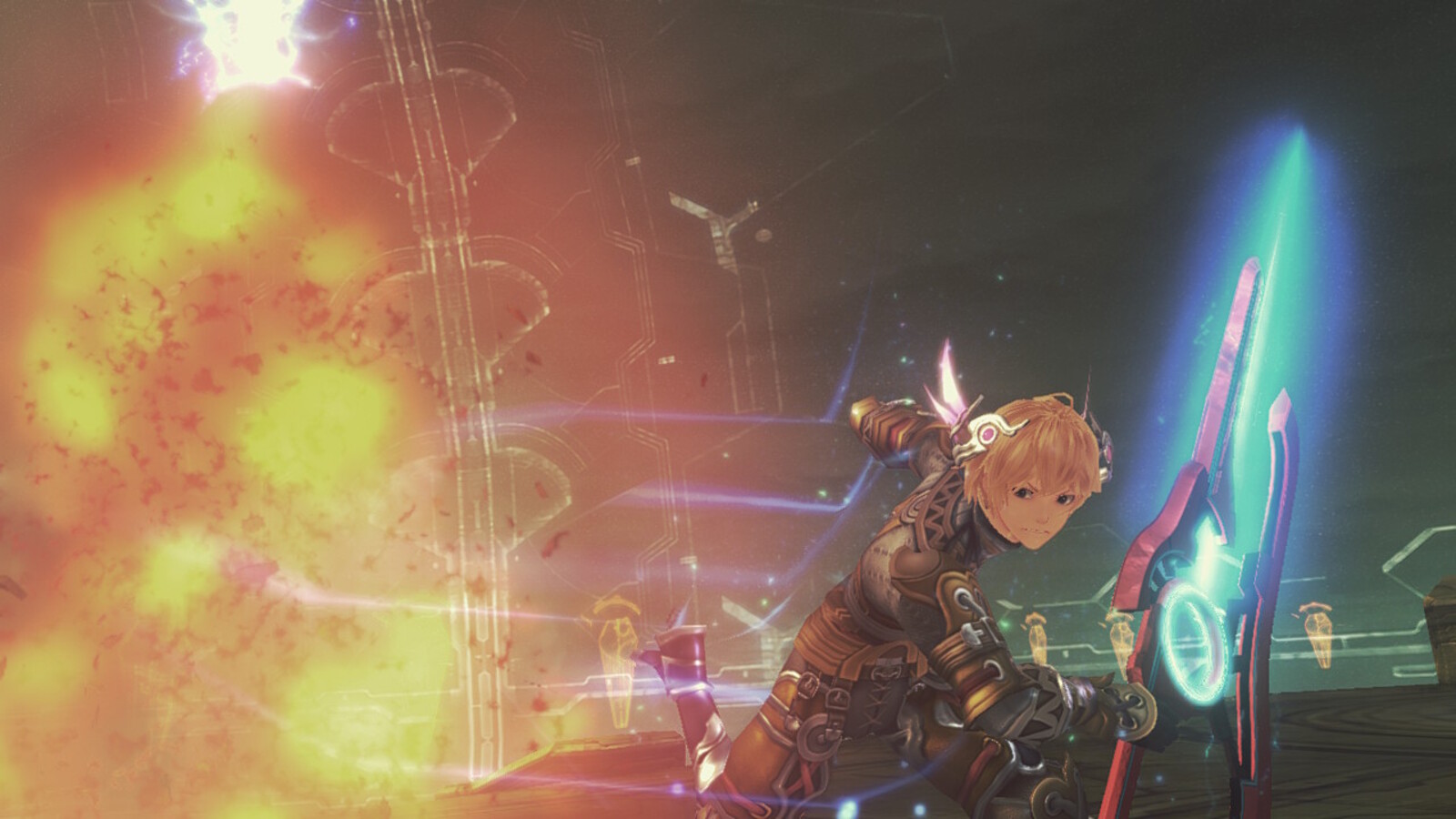
Gameplay
When engaging a monster, you only control the party leader. Other party members automatically attack. Certain arts can be applied during combat for healing, attacks, breaks and topples. You only directly control the party leader, with the other two members being controlled via the game AI. The position of your character in relation to a monster can affect using certain arts. There is some strategy in moving around your enemy and encouraging your allies, but most of the combat system devolves into just using the same combos. Some bosses are impossible without going back and leveling up via grinding.

I don’t enjoy games where the normal run of enemies and attacks doesn’t build up experience at a rate that let’s you progress through the game. Even without skipping enemies, the normal mode doesn’t feel like it’s possible to beat without heavy grinding. Popups for casual mode appear tauntingly after every failed battle. No experience is lost if you die, except being returned to the prior landmark. There is little consequence to death, other than maybe needing to re-walk a path and face more frustration.
The side quest system feels meaningless. The game makes it very easy to pick up new quests, with almost all of them being fetch, or search and destroy missions. It’s easy to amass a collection of quests that get solved by chance along the way, and the future sight mechanic lets you know which items you pick up will complete quests. There’s nothing really fun or interesting to them, and the timed combat area portals felt equally as boring.
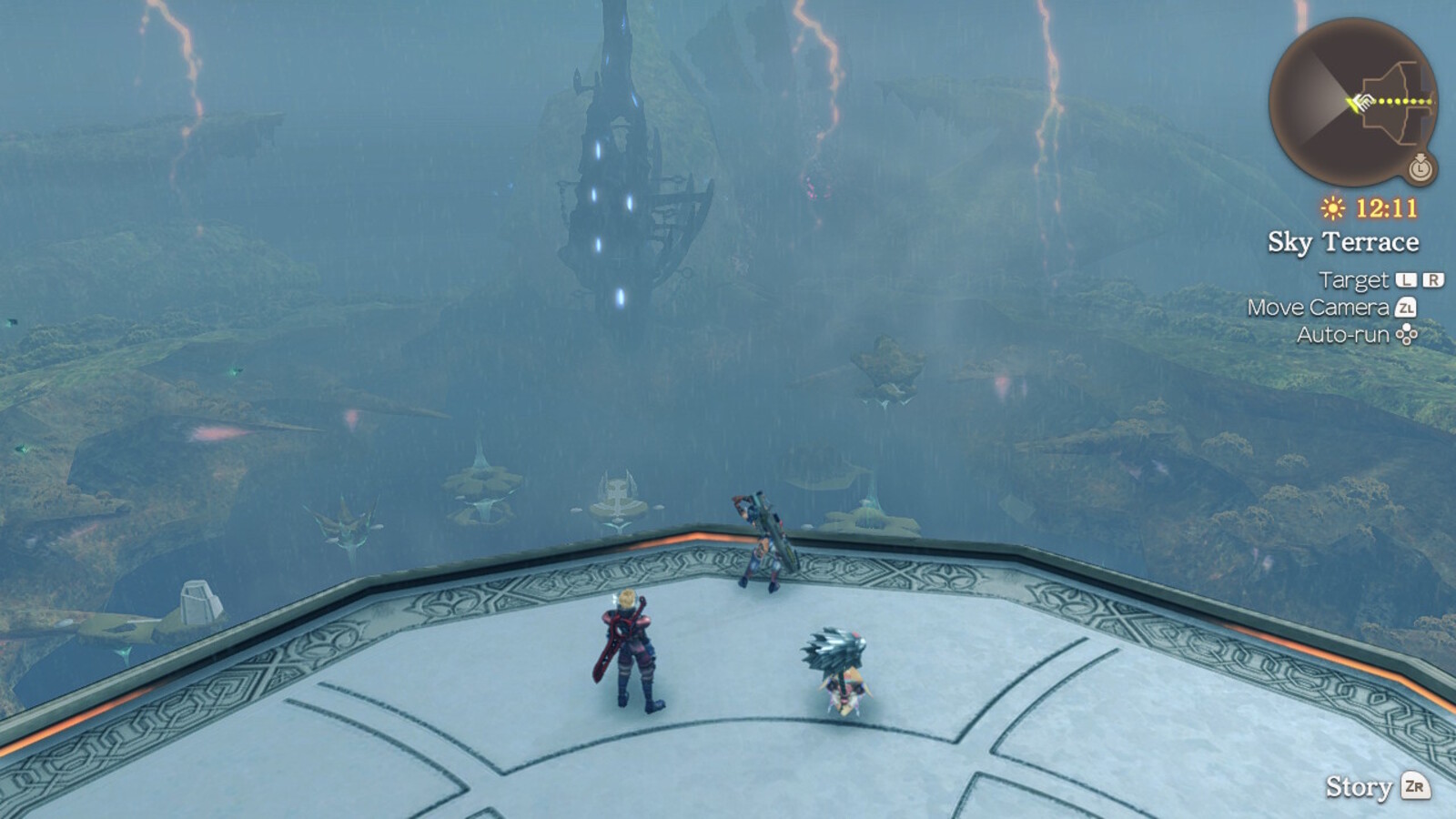
The overall gameplay felt interesting at first, simply for seeming original. However, I found the combat system terrible. The future sight mechanic, introduced part way into the game, interrupts the normal flow of the game constantly in a really annoying fashion. There is no way to dodge or evade attacks, making the combat system mostly level based. There is not much skill involved, only grinding.
After chapter 9, I became entirely frustrated with the gameplay. It got to the point where the story was no longer enjoyable, even as it got more complex and interesting. The gameplay is easily the weakest part of this game.
Story
The introduction is presented as a myth, and the origin story of the world’s foundation. What seems like metaphor becomes a very tangible reality with revelations about the Bionis on which the characters live. Occasionally you will see cut scenes and perspectives from the Mechon.

The story does tackle some deep philosophical ideas. There are questions about man vs gods, fate and destiny. Some of it does occasionally get long winded, and there are moments that seem to have too much exposition. However, for a video game story, it is quite engaging and thought provoking.
Overall, it’s creative and very well done. The story is the strongest part of this game. It draws the player in, and is the only thing that made the game worth playing.
World Building
For the time and platform Xenoblade Chronicles was originally released on, the graphics and artwork convey the very large size of the world. Not having played the original, I’m not sure how much has changed in the Switch version. Still, even with the remaster, I can see how the original artists pushed the limits of what they had to work with at the time, to convey the massive heights and depths our heroes travel through. The music fits really well, and has decent variety with consistent themes.
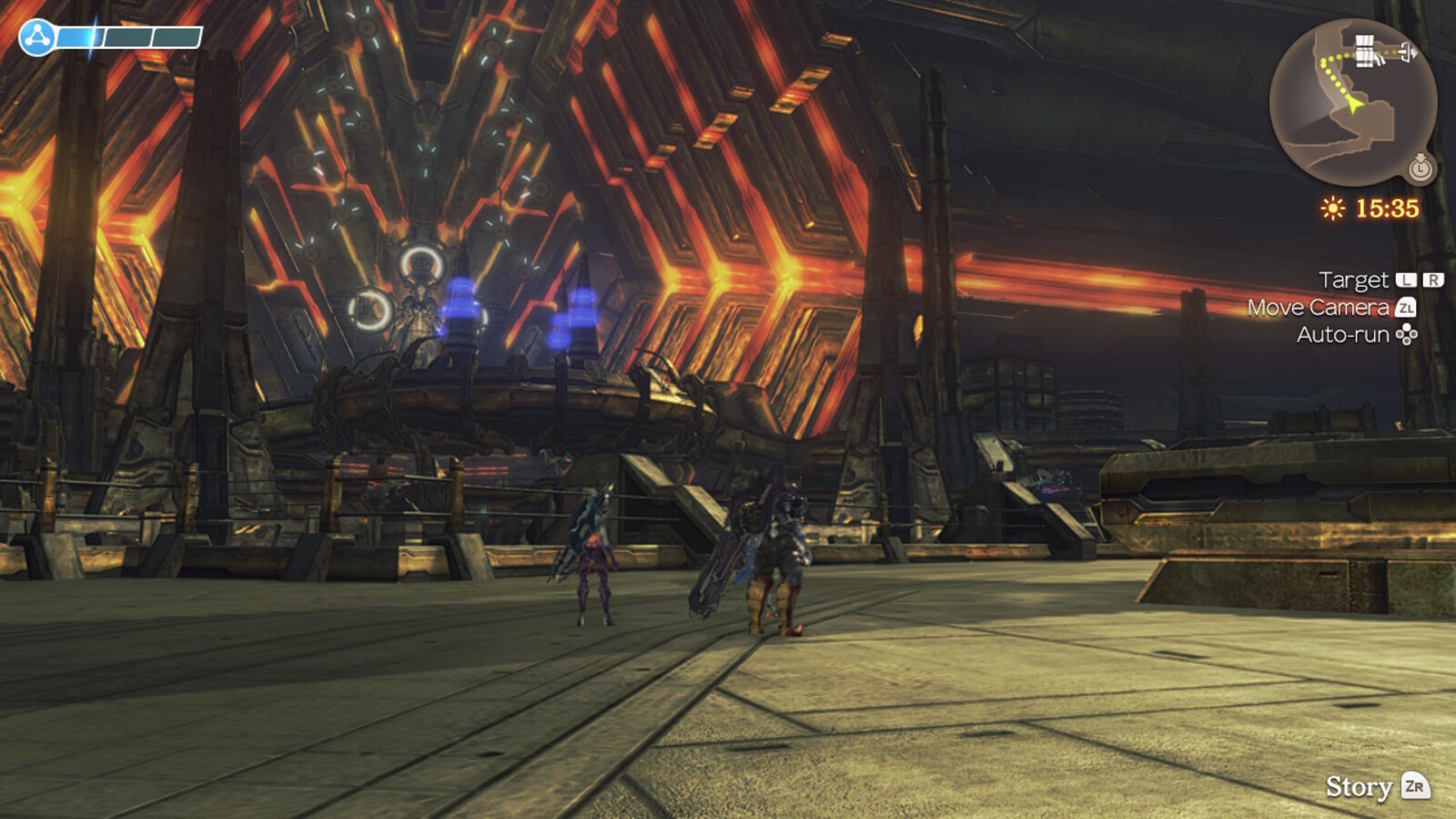
The fast travel is exceptionally fast, allowing the player to jump between nearly any point or old discovered secret. Unlike the combat system, the travel mechanics are smooth and do not get in the way of the player.
Overall
It took me a long time to get through Xenoblade Chronicles. By chapter 9, I finally switched to casual mode, which was still very difficult, but finally allowed me to get through the game. I know some people will say that casual mode ruins the gaming experience2, but I found it made the game considerably more playable, although not more enjoyable. The leveling is really unbalanced, and the game pushes you towards non-linear play, exploration and grinding. The combat mechanics are abysmally frustrating. The attempt of mixing pseudo-action combat, with automated attacks and special arts with cool-downs, felt like some of the worst gameplay I’ve ever experienced in an RPG.

It’s sad because the world itself is beautifully built. The music is good and the art is captivating. The characters would have all been delightful, except for the addition of Riki, who is somehow even more annoying than Jar Jar Binks from Star Wars. What could have been a really enjoyable and fun game, is truly ruined by a garbage combat system.
The Definitive Edition also contains the epilogue, Xenoblade Chronicles: Future Connected. Somehow the voice acting sounds terrible, and the game starts with the introduction of two Nopon, who are somehow even more annoying than Riki. Twenty minutes in, I determined it likely wasn’t worth finishing this stapled on extra content.
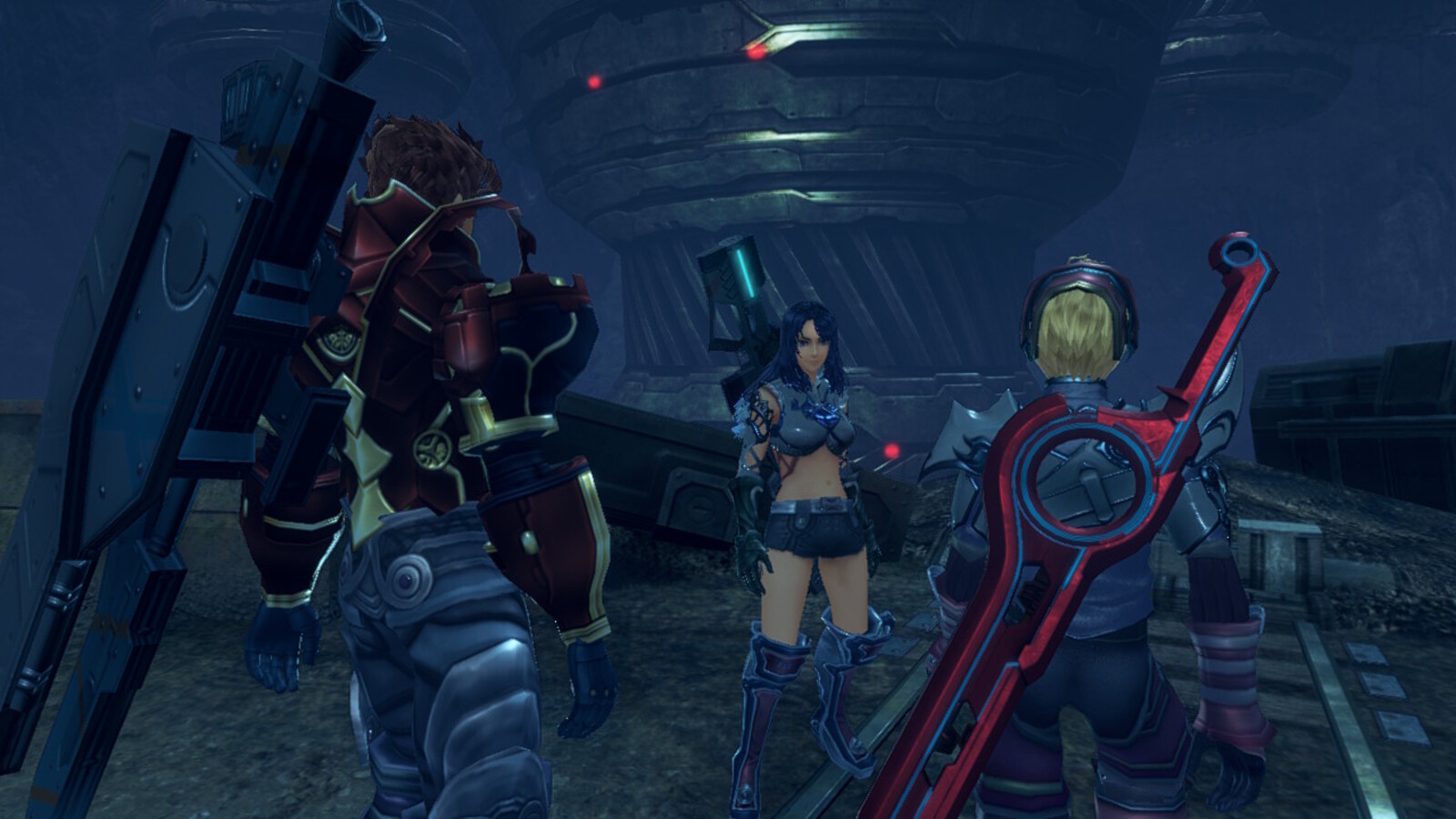
This game is part of a trilogy. I remember the first Mass Effect being frustrating with many of its mechanics, with the later two games fixing a lot of those issues and providing some of the best first person sci-fi RPGs I’ve ever played. Maybe Xenoblade gets better as well, but if so, it’s off to a rough start. It’s sad because the story, though it has its issues, is exceptionally good. However, the best story still can’t make up for a frustrating combat system, so awkward and tedious, that it made me put this game down for weeks or months at a time. It almost kept me from finishing this very memorable game.
Eternights
After having finished a game that took well over 100 hours, I was ready for something shorter on the PlayStation 5. Eternights seemed like a short title I knew little about. When I first started the game and saw some of it’s extremely basic design elements and menu systems, I wondered how this had gotten pressed and distributed on a physical disc. Although the UI could have used some polish, I was quickly thrown into some engaging combat and a fairly interesting world, in this post-apocalyptic, monster slaying, futuristic dungeon crawler set in Japan.

Story
At first I was afraid I had stepped into some sort of dating simulator with the opening scenes and dialogue. However, the player is quickly thrown into a world where you are running from monsters, and slowly paired with people to help you fight the Japanese zombie hellscape.
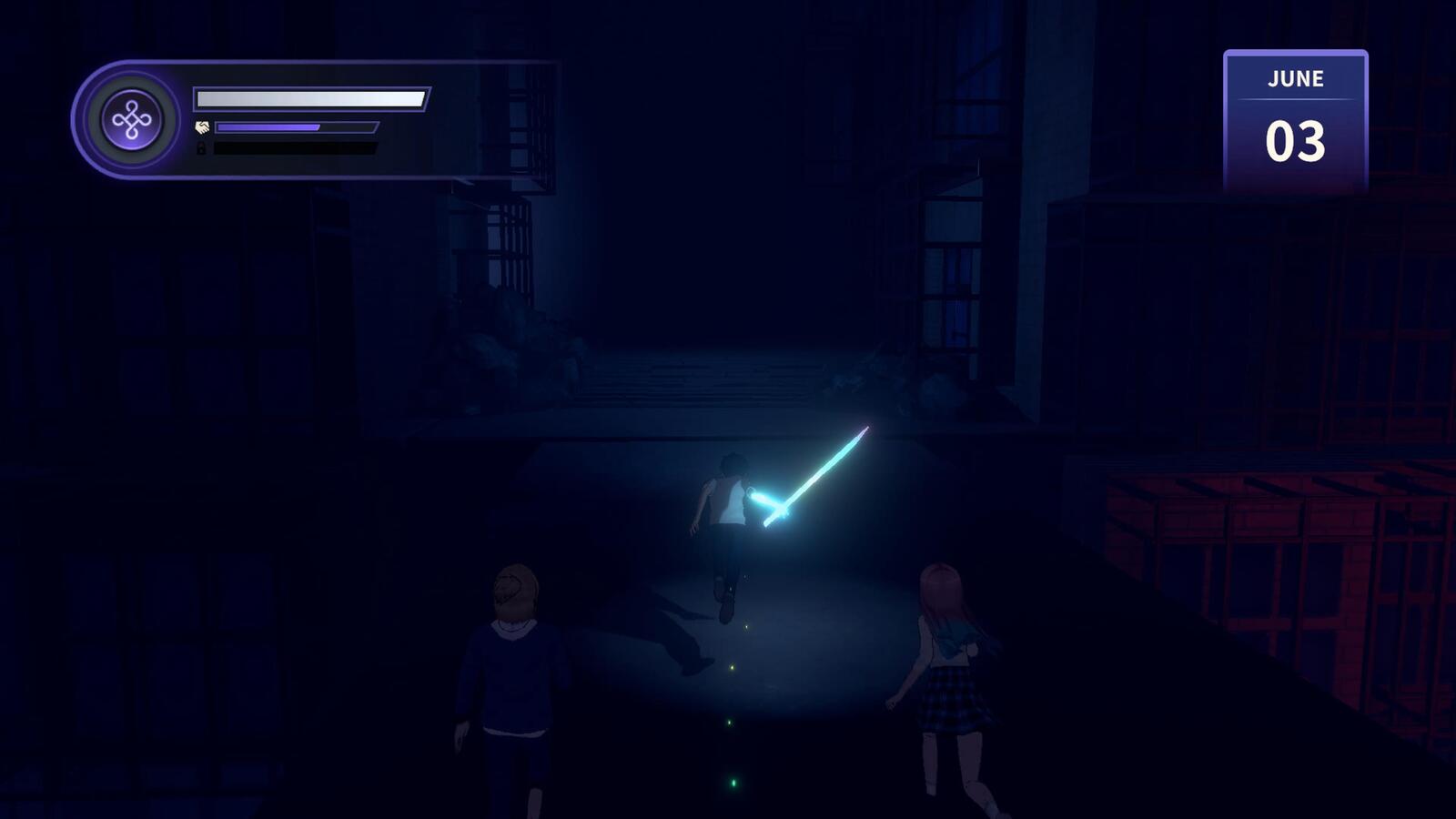
I would highly recommend switching the spoken language to Japanese as early on as possible, as it makes much of the game more tolerable. Most of the characters are quirky, and the game does seem to try and have fun despite it being “the end of the world.”
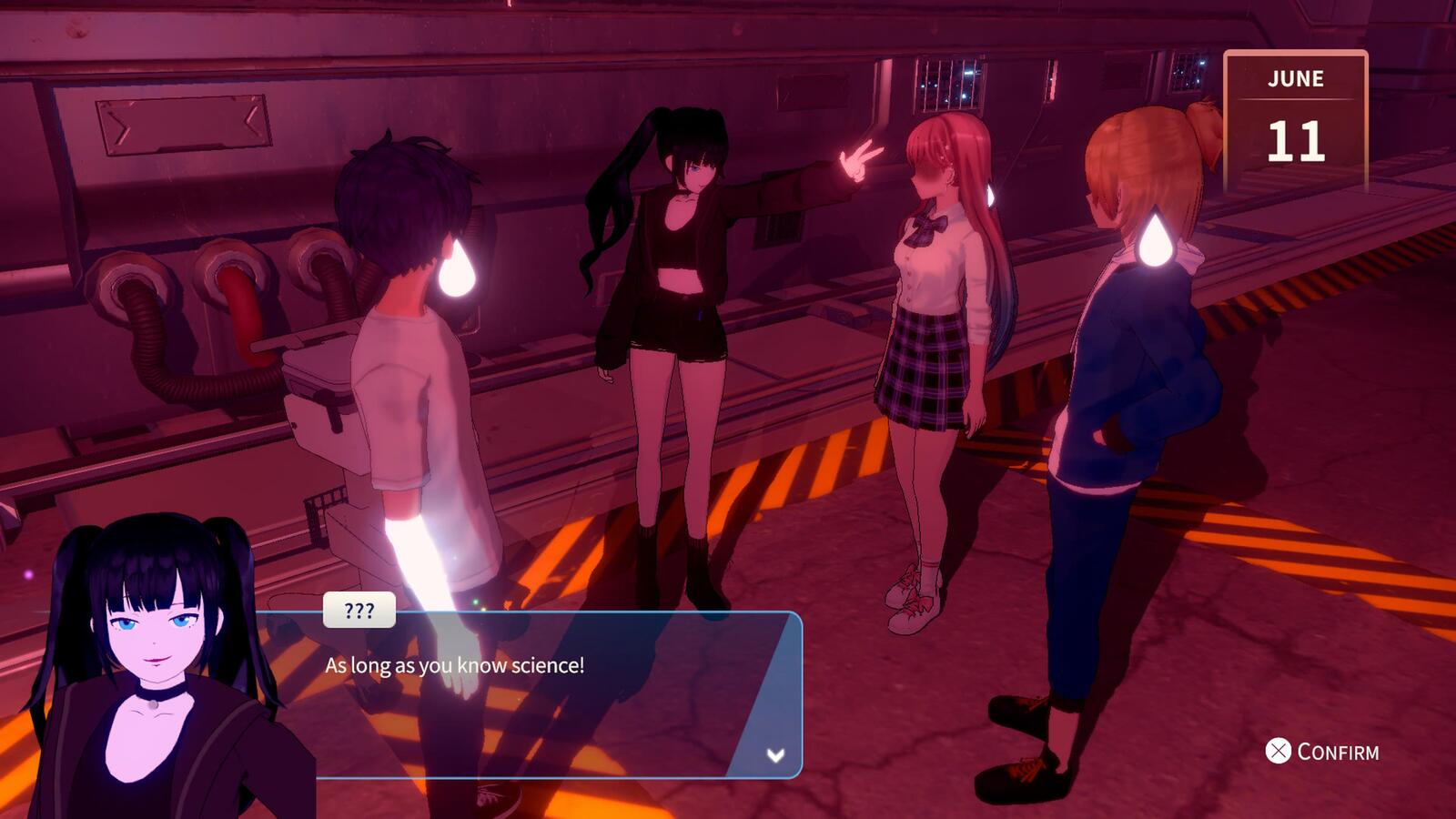
Although the characters are interesting, the overall story feels like a mix of basic and rushed. It tries to have funny moments while also trying to be taken somewhat seriously. The lore and motivations of the antagonists are messy, yet cohesive. Overall, the game’s emphasis seems to be more on individual character interactions, with the apocalypse backdrop stapled on. It does have some truly emotional and memorable moments, which do feel dark yet satisfying.
Gameplay
Eternights is a basic dungeon crawler, with your team’s home base being a train. Dungeons must be completed in a certain number of days (turns) due to some contrived event, similar to Persona 5. Unlike Persona, the combat is action heavy, not turned based.
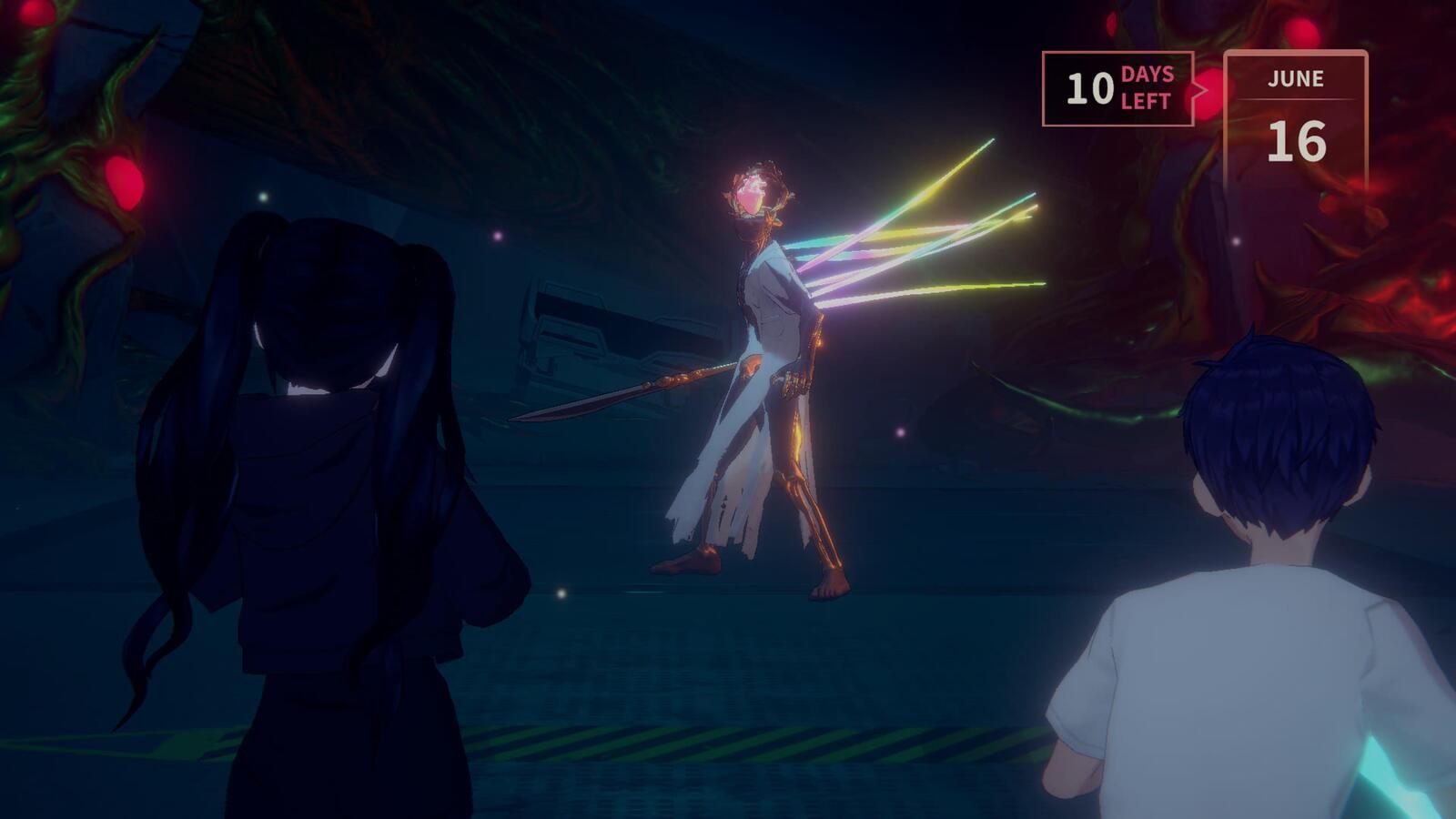
A light and sound indicate an attack, similar to Ghost of Tsushima. You have a very tiny window to initiate a perfect dodge. Many of the monsters are fairly hard, and the game is dependent on this dodging mechanic, which allows for your character to accomplish combos.
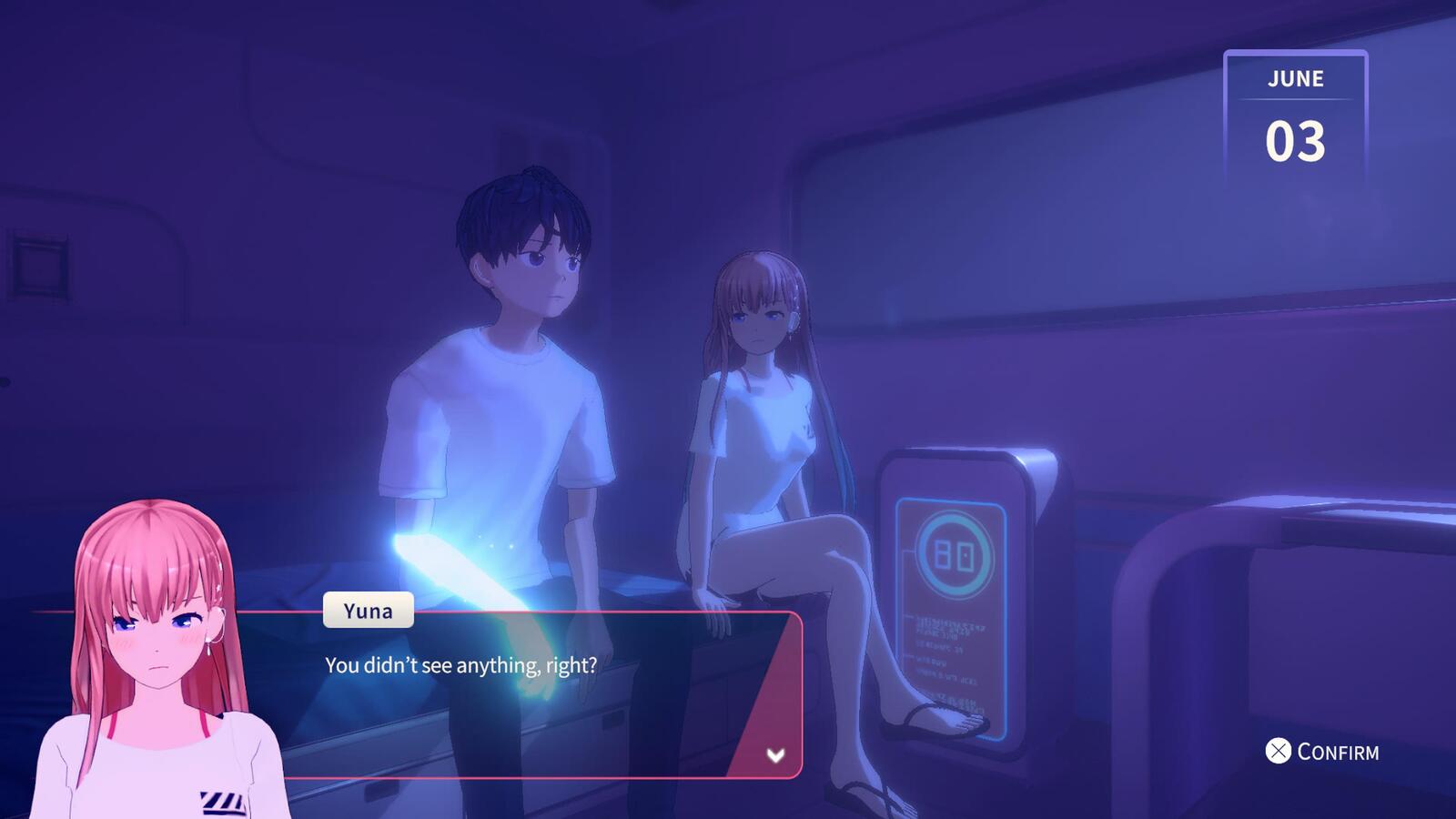
Although you may sometimes get material drops, there doesn’t seem to be experience from individual battles. The game also doesn’t have a map overlay, so it’s important to remember which direction you came into a room. Otherwise, you’ll be fighting the same battles over again. Save points can be used for fast travel and come in the form of floating cellphones.
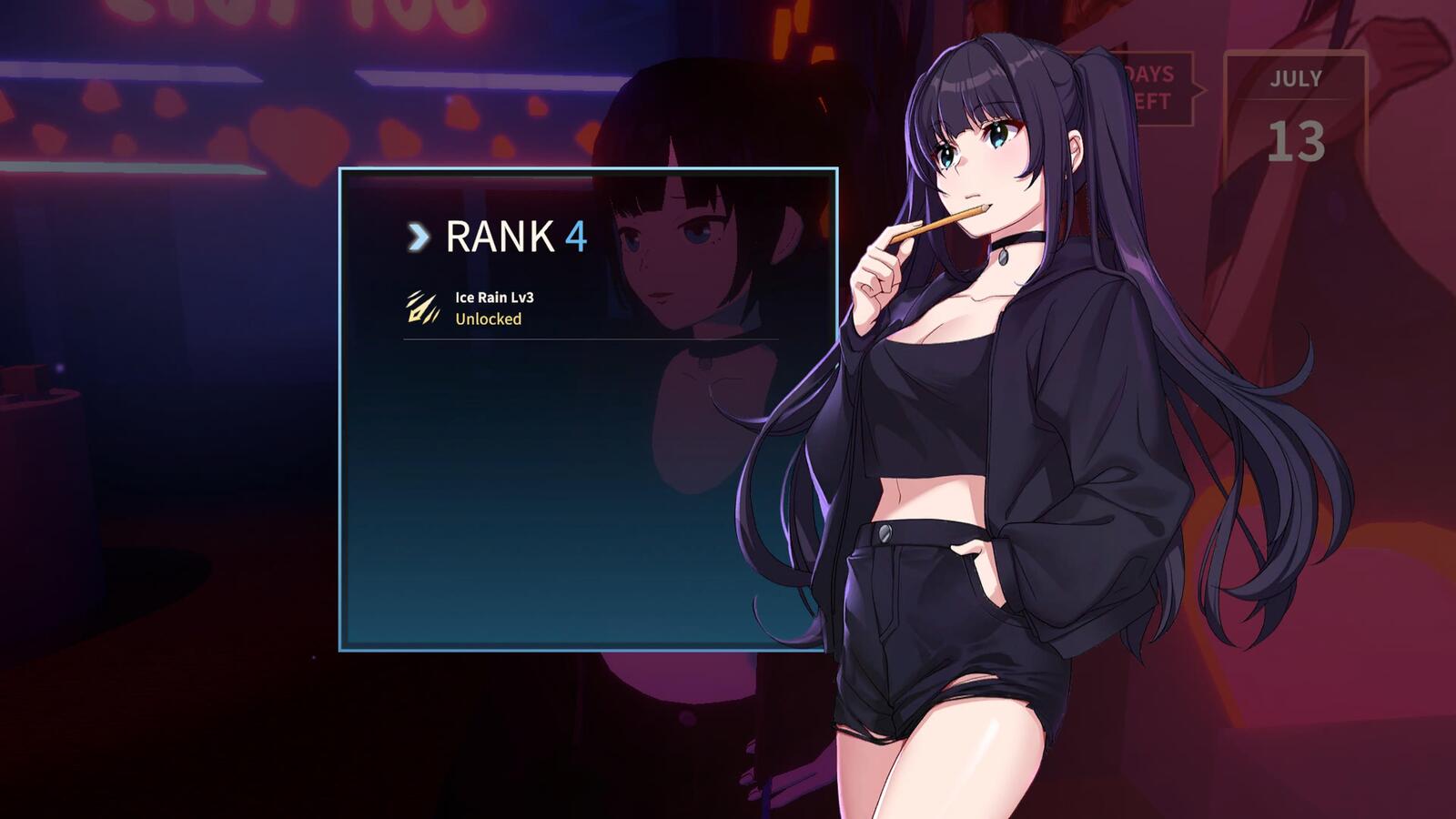
The game is fairly linear, and there are items and character interactions that can be used to upgrade abilities. Side characters you gain into your party give you additional abilities during battles, but are limited by cool downs and a gauge that can only be recharged by returning to the train; using up a day. Between dungeons, time at home can be used to rank up relationships with other members of your party, and explore side adventures.
Conclusions
The dialogue, adventures and individual character stories are the strongest part of this game. They make it feel like a dating simulator with crazy monster fights tacked on. However, the monster fights are still incredibly difficult. The dodge mechanics require precision and, for some bosses, require your to dodge before any indication of attack. It requires multiple tries to identify the tactics of different monsters. For some enemies, the precision dodge mechanic is so poorly tuned that I felt like I was spamming dodges in hopes of getting a perfect one.

A lot of the game just feels unpolished. There are no ending animations for the boss sequences like in brawlers such as God of War. Instead the combat just fades out. Scene transitions use circular checkerboard swipes. The UI elements are all very squared off. The game has all the foundations of a decent game with okay story, but just feels a little basic. It’s not buggy or glitchy, and it does feel like work went into making a smooth linear experience.
For its price of just over $20, and its overall game time of 16 hours, I feel like this title really hits the sweet spot of price to value. It’s about the right length to be enjoyable, even if it’s not quite long enough to fully flush out a completely built world. It’s an addictive brawler with role playing elements. Although nothing exceptional, it’s still a fun game to play, with interesting characters, deep colors and creative animation.
Senran Kagura Shinovi Versus
I had watched the first season and a half of the Senran Kagura anime, but Shinovi Versus is the first game I’ve played in the franchise. It’s ninja fighting game where the female warriors use their mastery of the shinobi arts to manifest protective clothing. As they take damage from other shinobi, their clothing begins to disappear. It’s exactly the type of game you’d expect. There is a story, but it’s only there to take away from the anime girls and their fan service battles. The game is short, and doesn’t take itself too seriously.
Gameplay
The fighting mechanics are basic hack and slash. Most missions involve hacking through large amounts of ninja students, before taking on a rival from one of the other academies. A lot of the waves of enemies feel like they are just there to warm up on attacks and combos, before the main battles. The opening waves often just get repetitive, grindy and annoying.
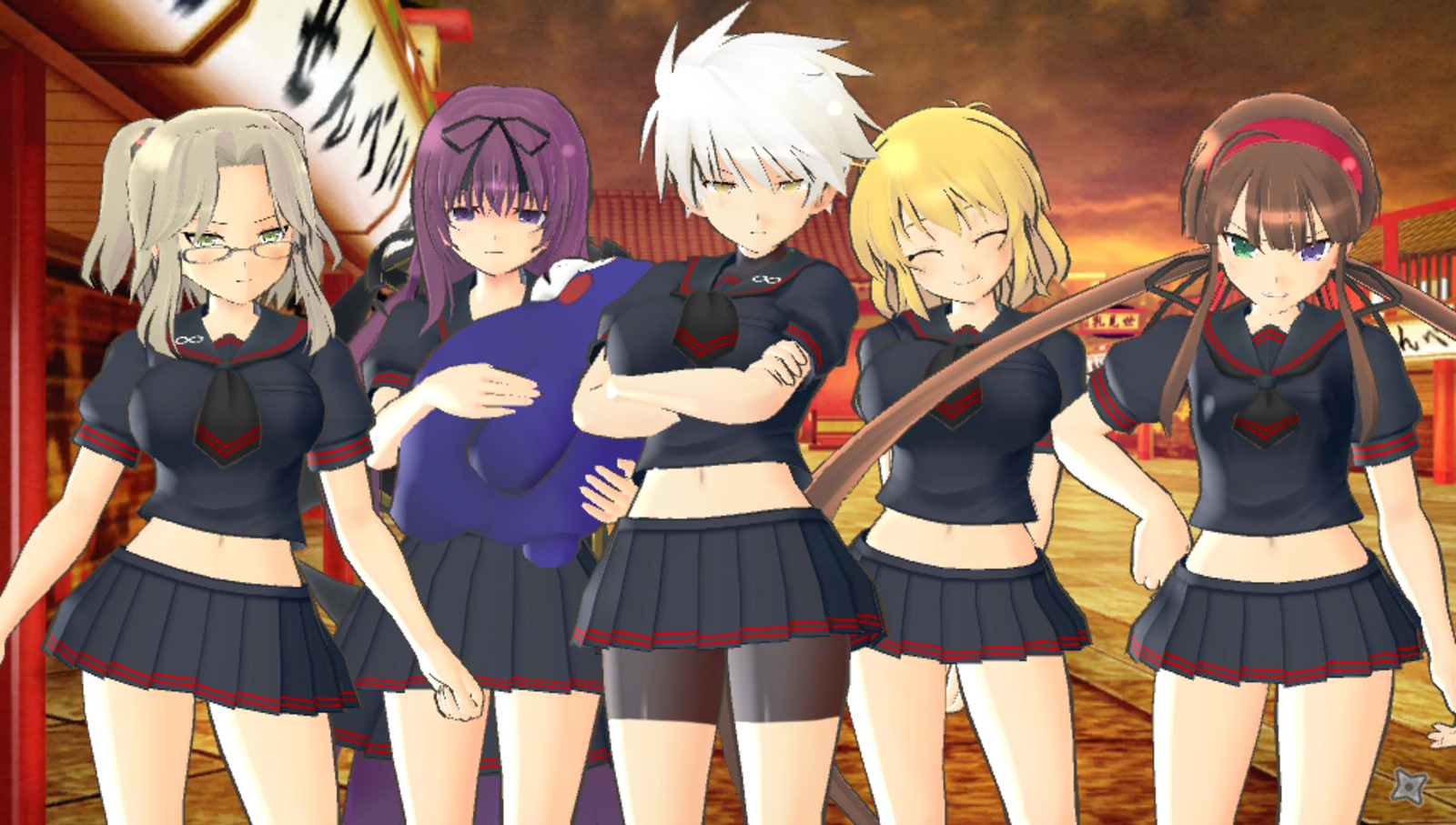
Each student does have varied attacks and strengths. For example, Katsuragi can almost glide in the air in her evasions, and launch powerful close range kicks. Meanwhile, Hibari’s moves are intentionally bad, matching her personality as a terrible and ridiculous fighter.
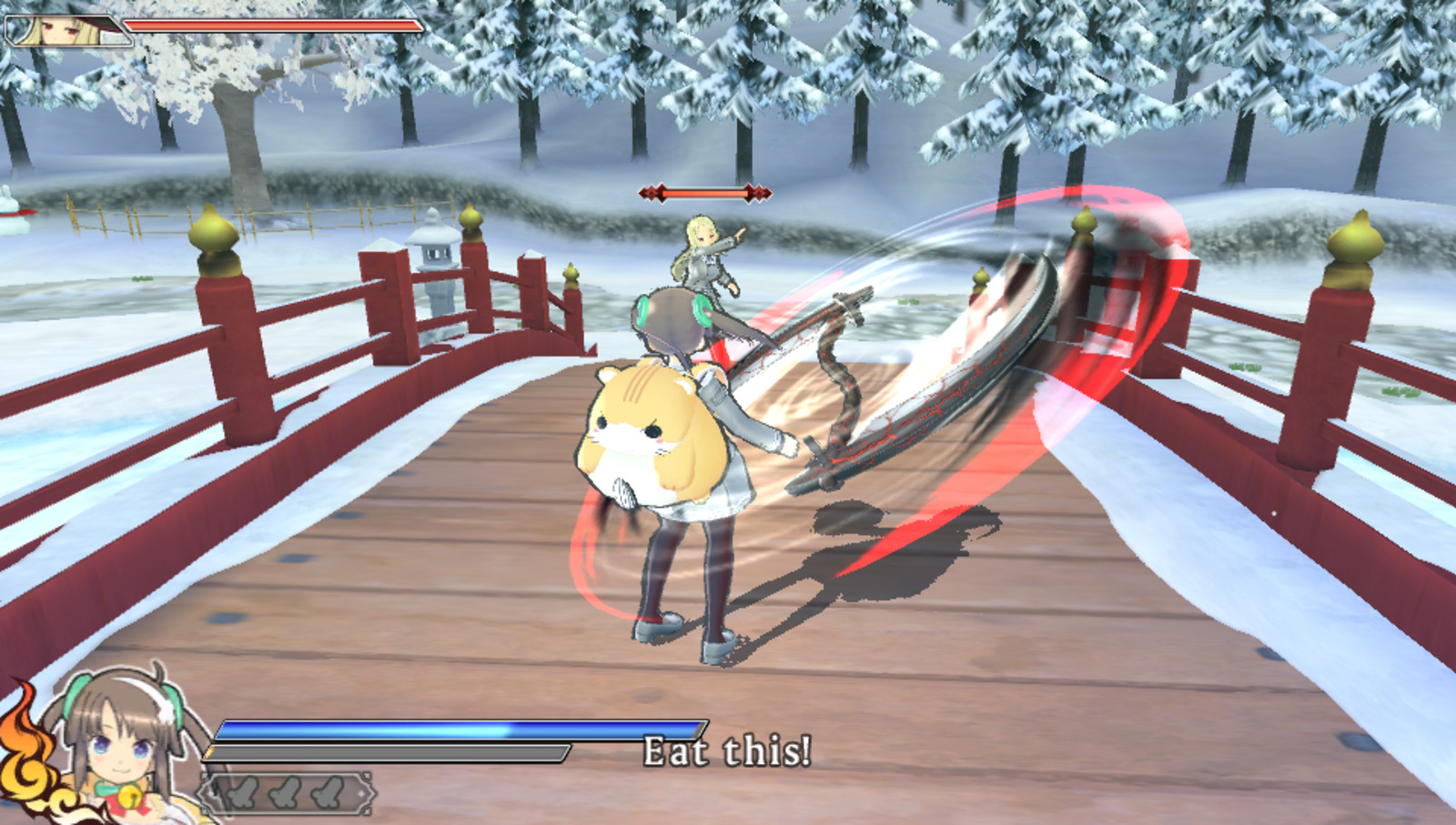
The fighting is not great. The battles are designed for both characters to lose all their clothing. There’s some dialog between them, but it’s just there so you can see each character with their clothing torn to shreds.
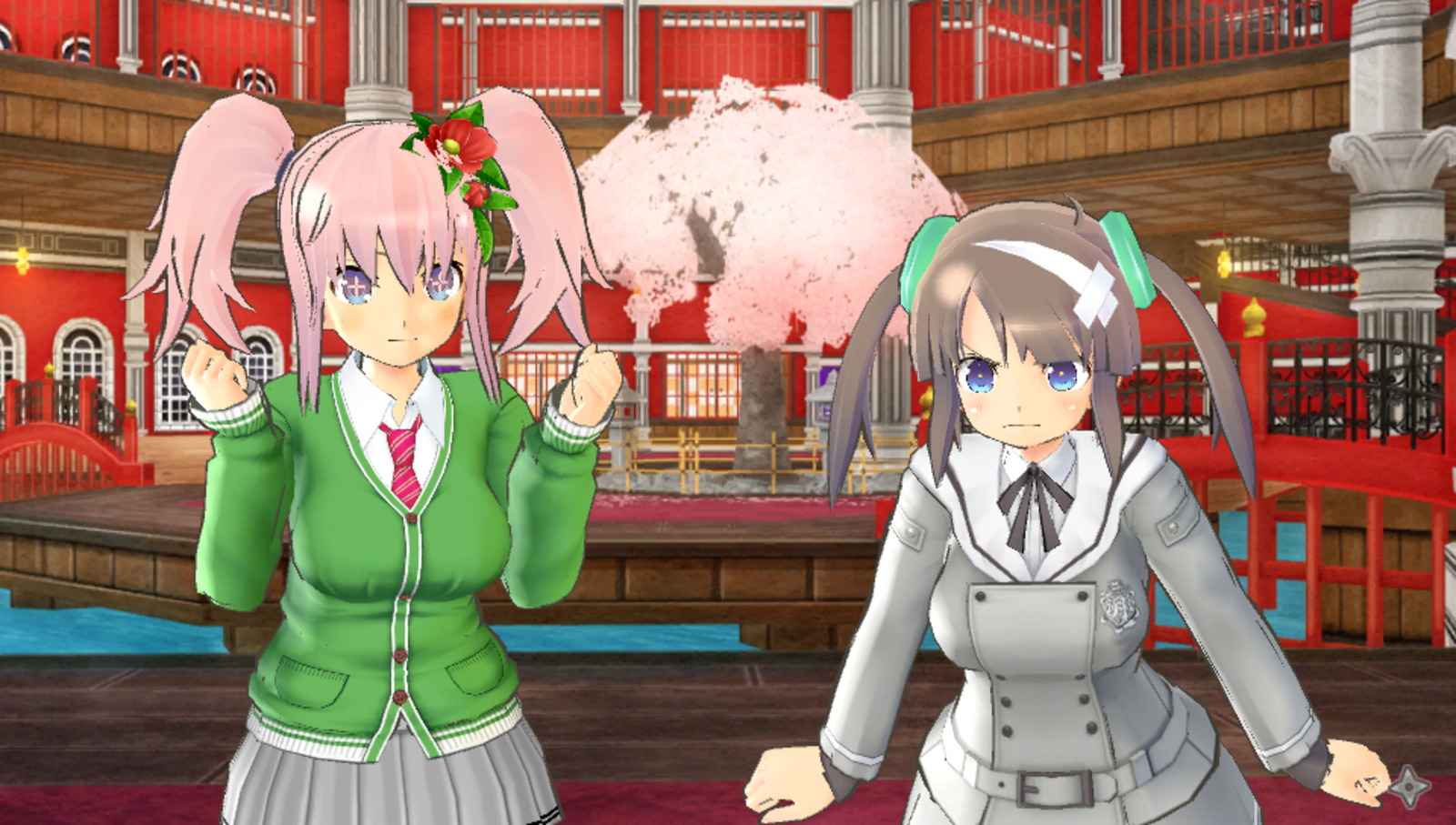
You earn money with missions, but it won’t help you upgrade abilities. It’s only used to buy additional outfits and lingerie for the girls. You can also poke them inappropriately using the Vita’s touch screen in the dressing room.
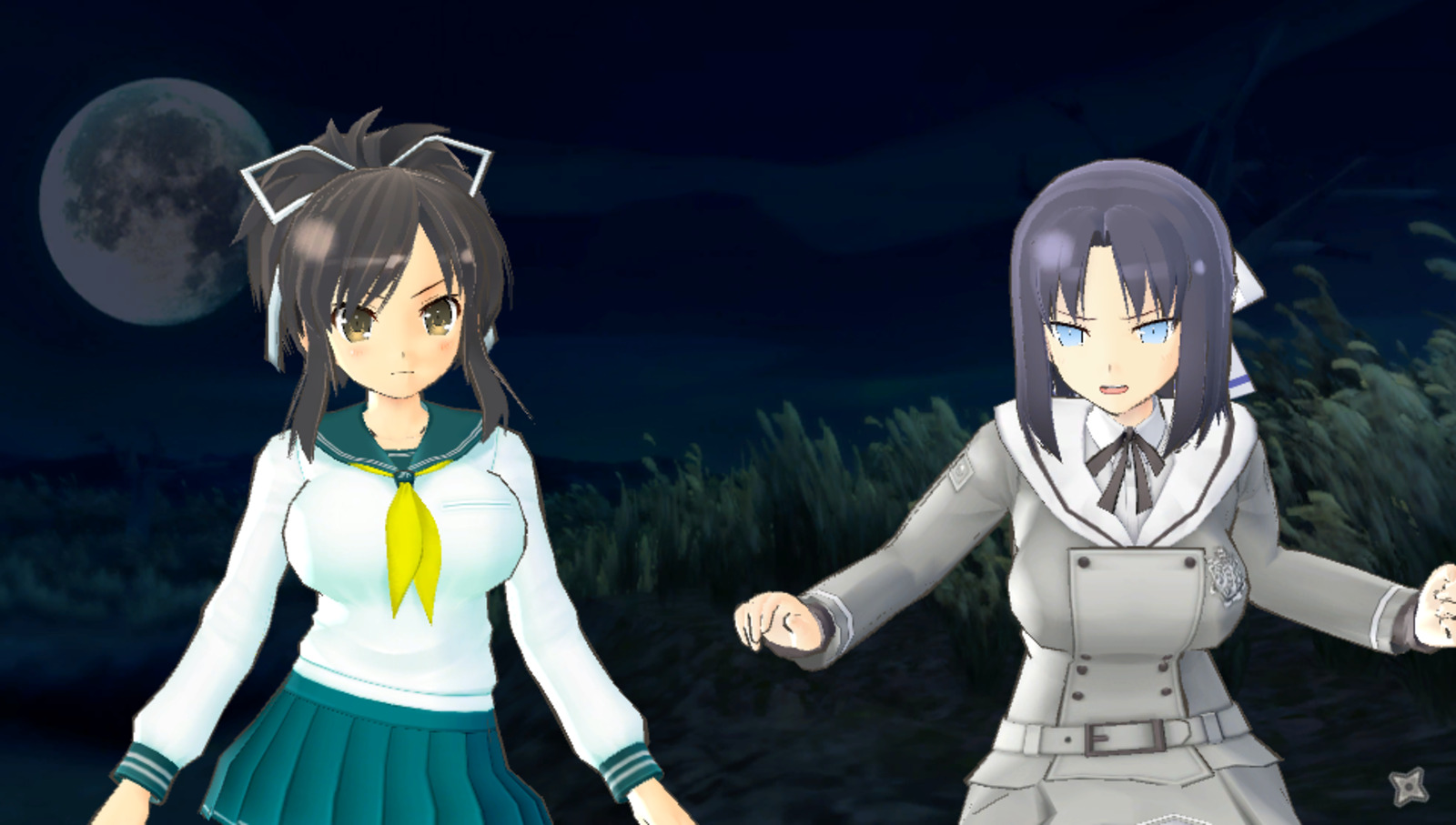
Story
All the story is told via dialog on screen. It’s either two characters talking to each other, or a background with narrative overlay on top. The creators didn’t even go to the effort of having still frames of relevant characters during the narrative segments. Several of the characters you never see at all. Some of the text just goes on forever, with bad exposition that just gets in the way of the action.

The general theme of the game is around a very simplistic concept of good versus evil, yin-yang, or sword and shield. Some of the side character story is cute, but it’s all pretty basic and uninteresting. I wish the designers had told more of the story with animation, or at least drawn out the characters in a manga style. If I hadn’t seen the anime, the grandfather characters would have just been confusing.

Overall
It took about nine hours to get through the main story on this game for one of the shinobi schools. There are three schools, which I’m sure are equally boring. Playing Shinovi Versus does make season two of the anime make a little more sense, but given the quality of the content, I’m not sure that really matters. The girls are cute, some of the dialog is really funny, and the story isn’t horrible, but the combat is annoying. It’s not really worth playing unless you like a good laugh, and enjoy the idea behind the entire franchise.
Unicorn Overlord
I was looking up Vanillaware titles a few weeks ago when I noticed they had an upcoming release. I loved 13 Sentinels: Aegis Rim, and decided to preorder Unicorn Overloard. I started playing it the evening of its release day. At first, I had the feeling I’d be disappointed by this title. Although I was thrown directly into gameplay, the dialog was fairly basic and the opening battles were automated. I wasn’t quite sure what I had gotten into, or if I was in for disappointment. Several hours in, I had gotten use to the interesting fighting mechanics. The dialog doesn’t really get much better, but the gameplay itself is very flushed out and addictive. The artwork is surreal, the music is well scored, and there is an incredible attention to detail. Even with a fairly basic story, the world building and lore were well flushed out. I found myself playing this game for hours a day, exploring the beautifully constructed world and enjoying the challenges of each mission and side quest.
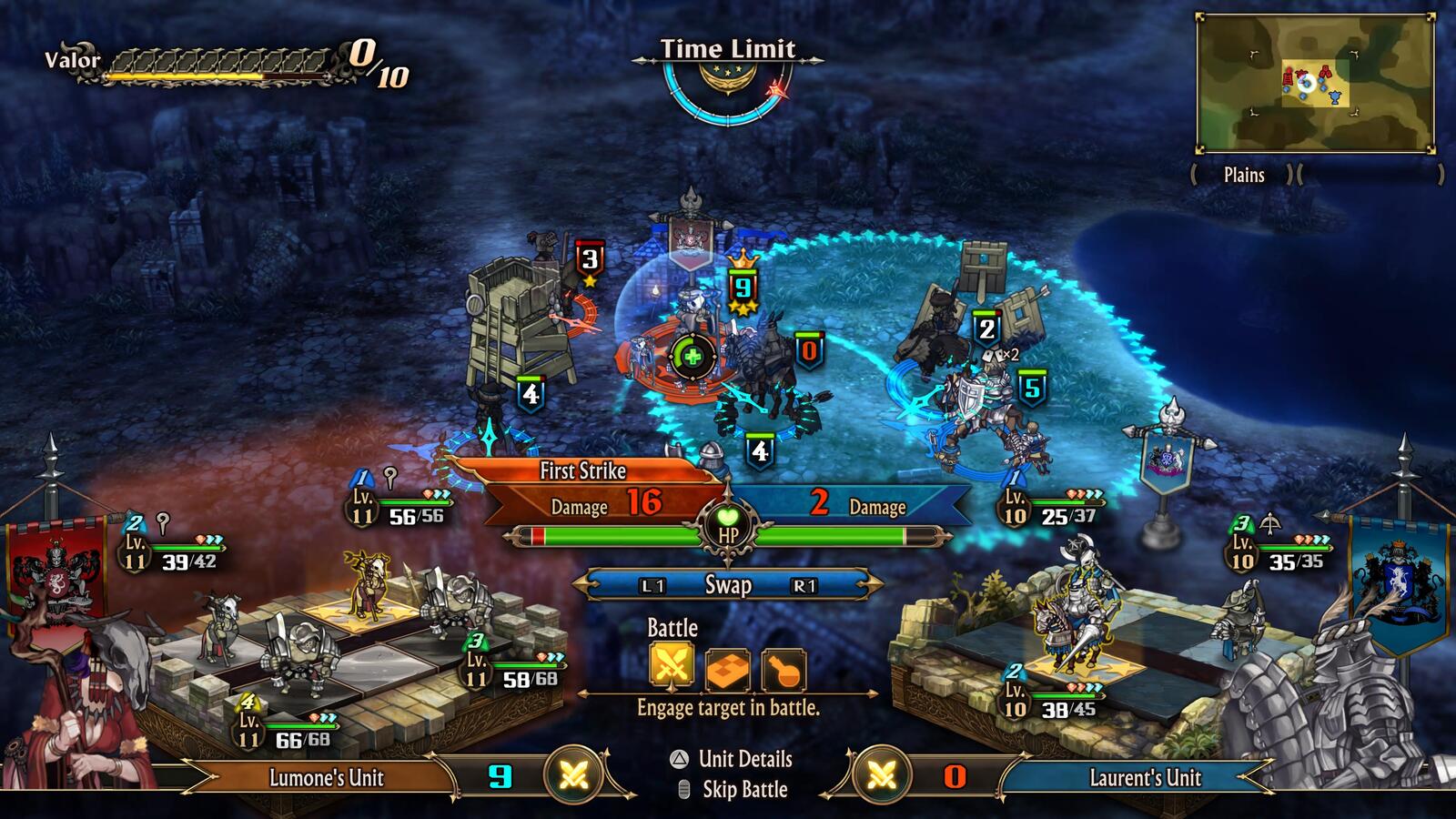
Story and Dialog
Translators for Japanese games have come under considerable criticism recently for outright changing story and dialog from the original writing, both in games3 and anime4. Some companies have considered using machine generated translations to combat some of those issues5. There has been some criticism for Unicorn Overlord, with localizers taking some of the more basic dialog from Japanese and expanding it into a more flowery Victorian style of writing6.
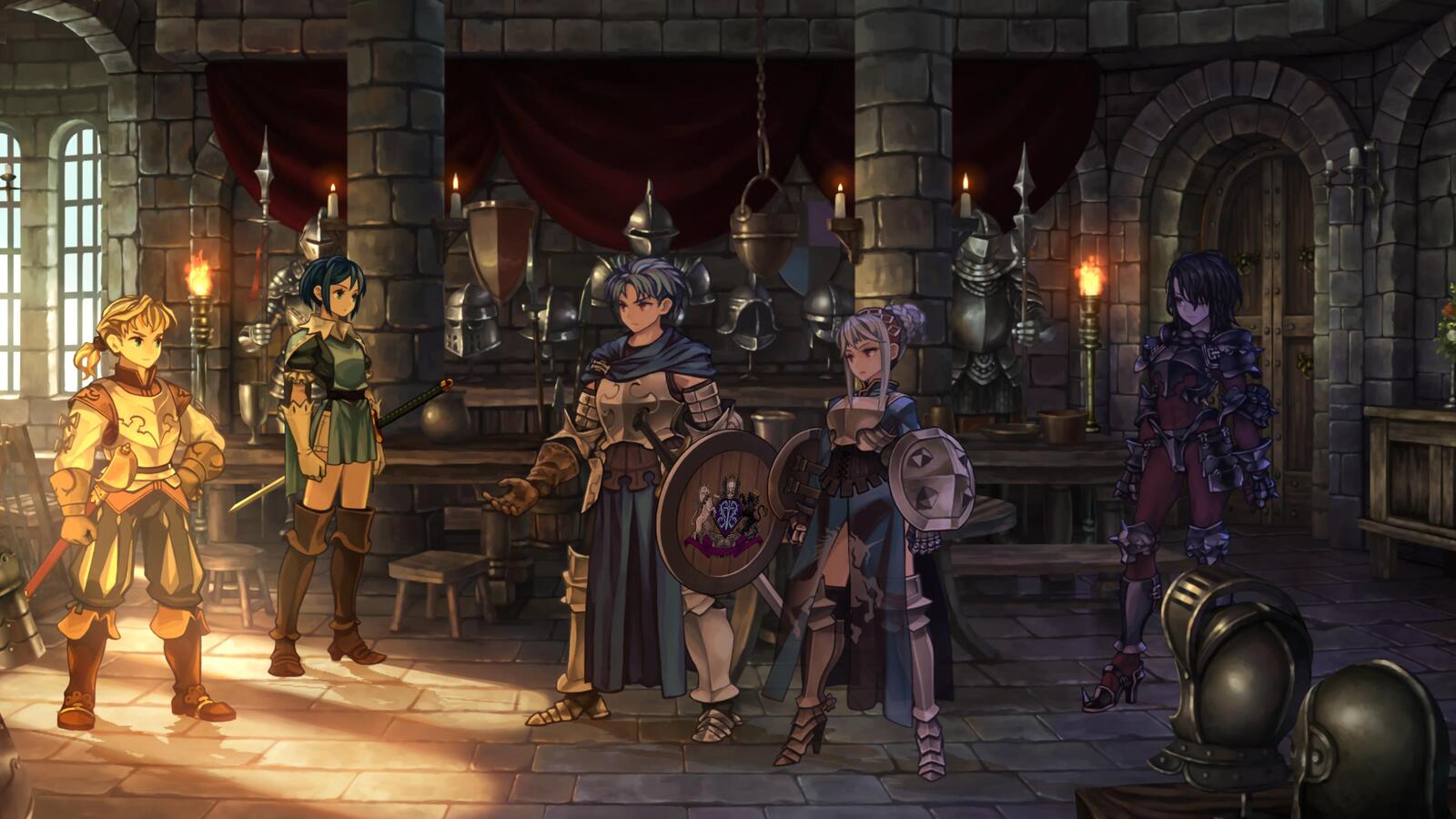
When I first started playing this game, I felt like the dialog was rather bland and simple. It’s a fairly straight forward good versus evil story. Yet, there are a few difficult choices, centered around themes of forgiveness and redemption. The changes in translations I’ve read about seem to make the dialog more verbose6. Yet, from what I can tell, they don’t really take away from the game. They might even make it slightly less boring, at the expense of being more embellished. I briefly tried using the Japanese audio for two of the missions and I would not recommend it. The Japanese voices do not fit the fantasy setting of the world, and the voice actors themselves are not very good. If it were a samurai game, the Japanese with English subtitles would be more appropriate. However, the best way to play this game is in English.
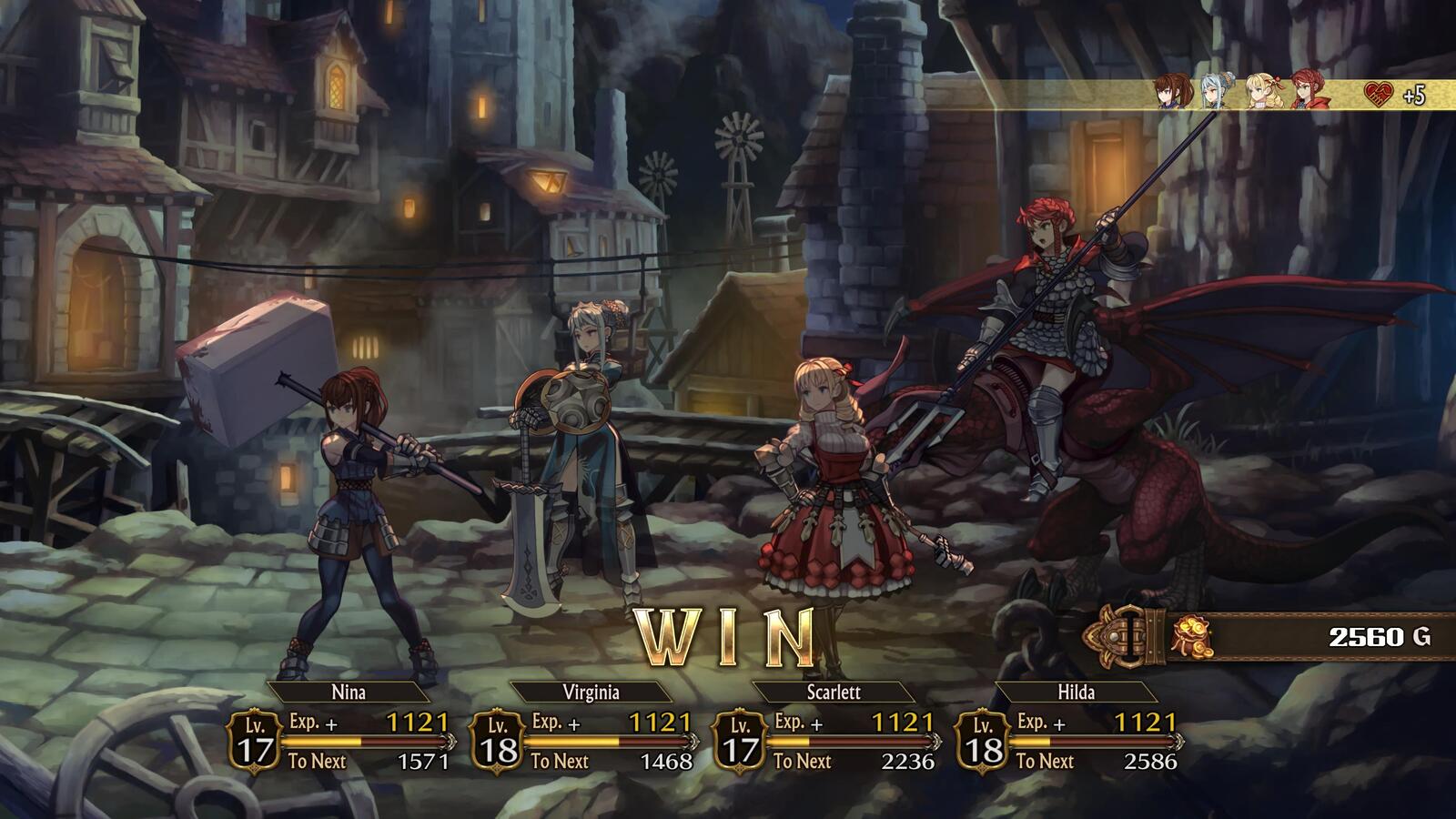
There are a lot of characters in this game. Early on you might supplement your squads with mercenaries, but I’d recommend dismissing them as early as possible to focus on building the skills of the massive cast. Having characters fight on the same squads, or share meals together, allows them to build rapport. Conversations can appear on the map once building these relationships. However, these moments don’t have any voice acting, and are typically just animated on the map instead of in a closeup. There are a few that are cute, and fewer that contain any real depth. Most of these scenes are silly little friendship stories, and they’re usually boring or disappointing.
Overall, the story is the weakest part of the game. The game does eventually flush out the lore of the world in some well done reveals. The world itself is very interesting, but the characters themselves feel a bit thin. Although their combat mechanics and abilities are unique and distinguishable, their personal stories all feel a little bit flat.
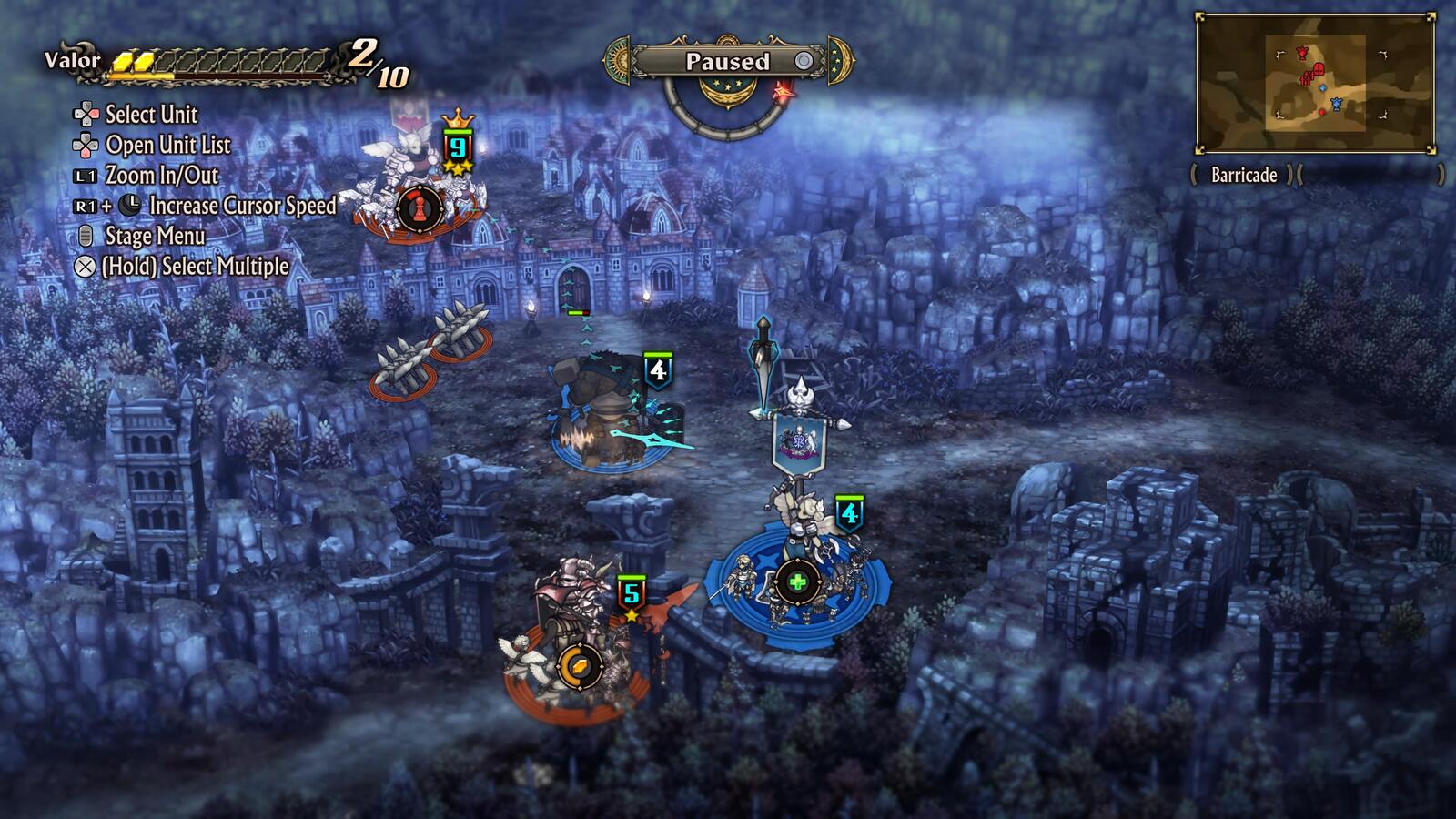
Unicorn Overlord is a great example of how even with unexceptional storytelling, the gameplay itself can do a lot to tell story in combat, and really carry the game.
Gameplay
The battles in this tactics game are automated. Instead of entering a battle and selecting each attack, you organize characters into squads, and define the order in which actions are prioritized. I haven’t played a lot of tactics games outside of the Fire Emblem series, and I’ve never encountered this particular type of game mechanic. It was a bit off-putting at first. However, it made more sense once I treated each encounter like a single attack in any turn-based role playing game.

Honor points can be used to increase the number of characters that can be positioned on each units 3x2 chessboard layout (up to a maximum of 5 units). Estimated results are shown before a battle starts, allowing the player to move around characters and change tactics.
In any role playing video game, there’s a series of calculations, random number rolls and comparisons made before each attack. Unicorn Overlord’s interface brings many of those hidden mechanics to the surface. The game essentially gives the player an if/then logic board that can be easily configured for each character. It forces the player to think about their entire strategy ahead of time, in ways they might not if deciding each move organically.
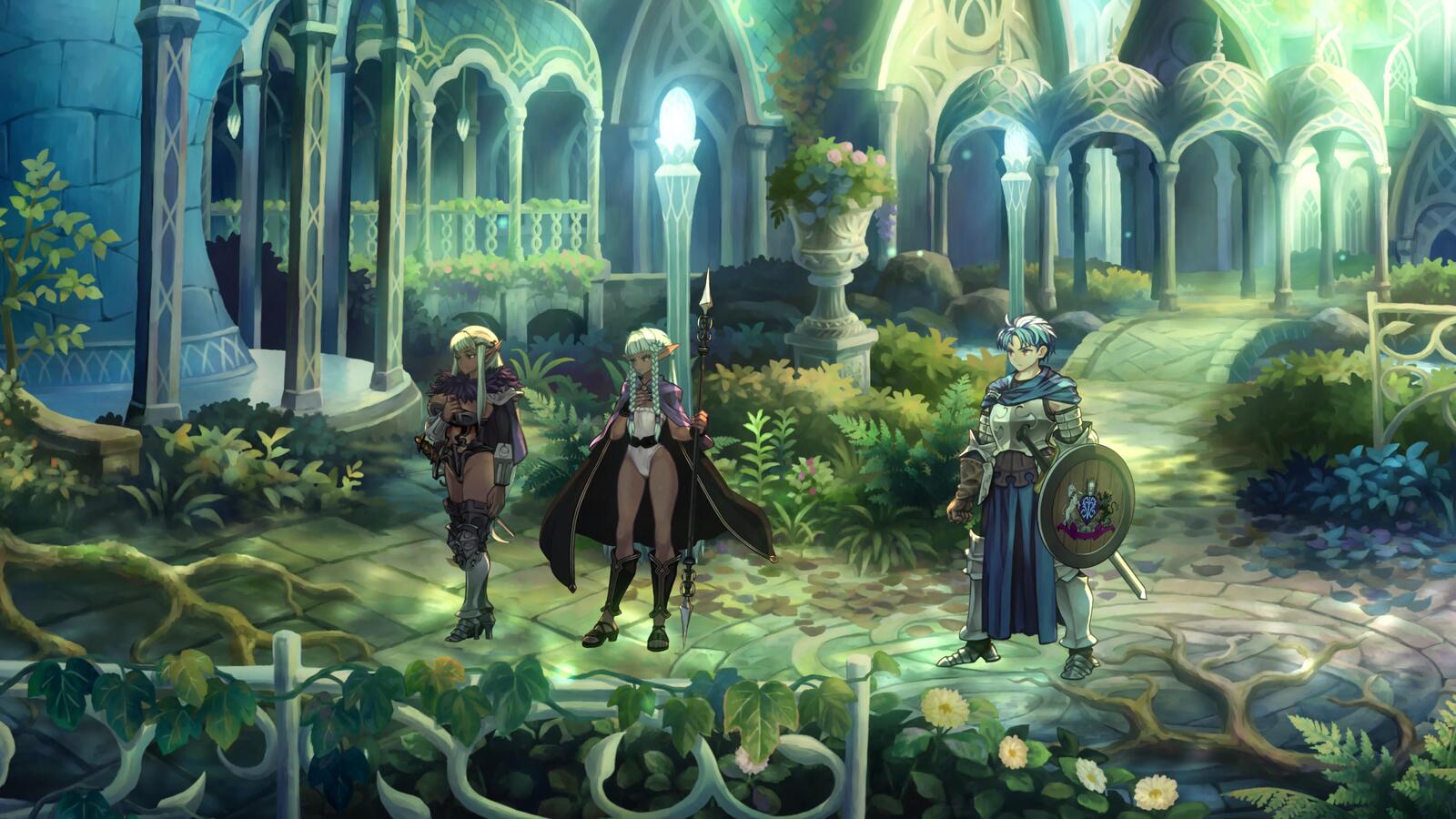
It requires a lot more thought than other strategy games. The battle animations can, thankfully, be fast-forwarded or skipped all together (although you won’t see the details of why your configuration succeeded or failed if you skip).
The individual teams don’t move around on a grid system. You select each team and guide them to position or targets. You can set way-points, and if you get to close to an enemy, a battle might begin you didn’t anticipate. You can pause at any time, so there’s not a lot of stress as far as making quick decisions. There is a time limit for the total amount of unpaused game time.
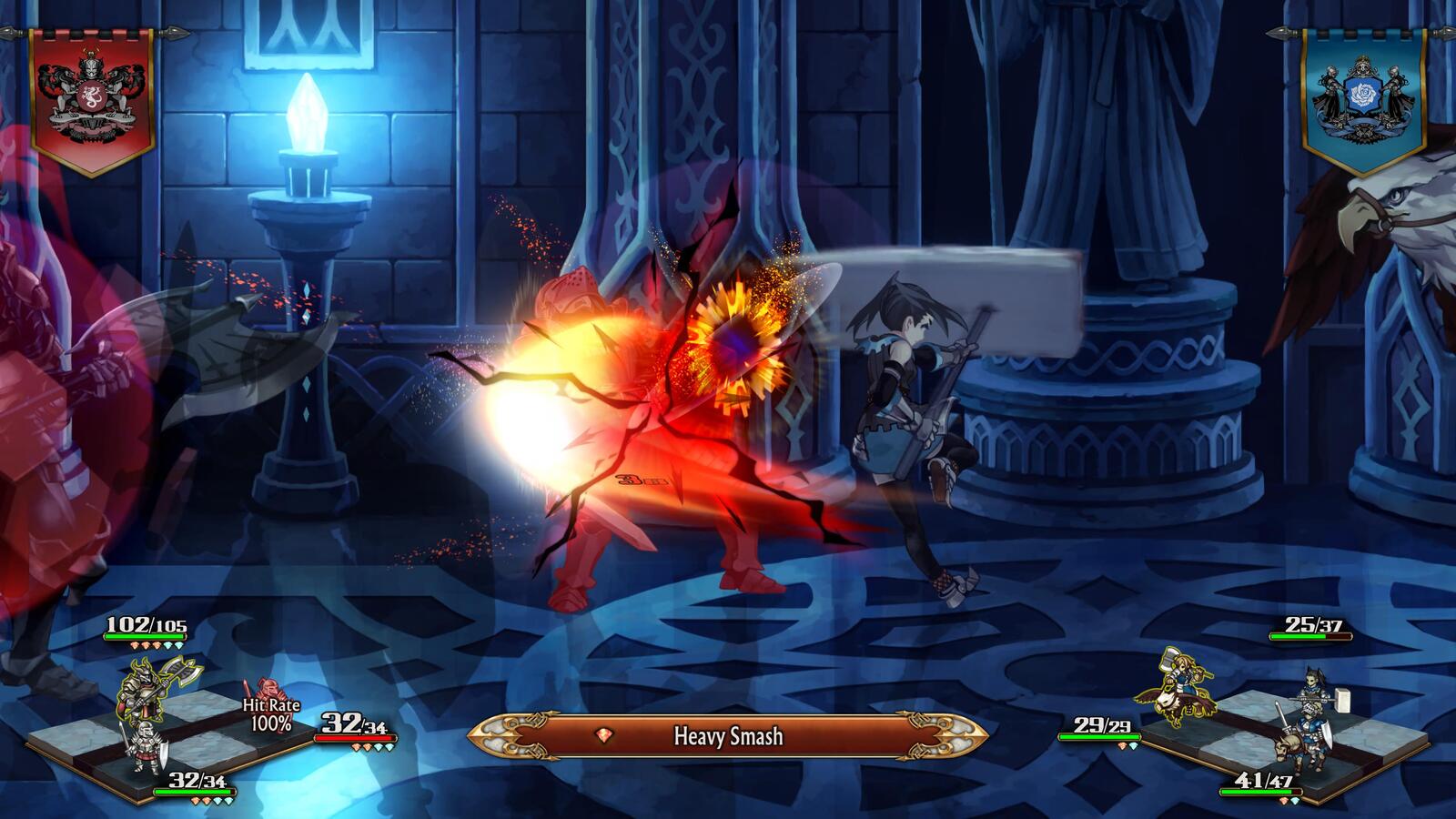
It’s a very weird and unique game system. It might seem overwhelming at first to some players, but the opening levels on the normal mode can be played through with the default layouts. As the game continues and new skills are introduced, players are gradually directed to customizing strategies. It’s done in a way that doesn’t feel overwhelming. Any stage can be replayed from the beginning. Leaving a stage resets your characters to the same number of consumables before entering it, reducing the possibility of getting stuck or taking a loss from being overly ambitious.
World
When I told some friends I had started playing a game called Unicorn Overlord, they asked if it was a mobile game. It does sound like a mobile title, but there are no in-game purchases to attract gambling addicts. There is a coliseum with some online battles, but I played my copy in offline mode. The map has resource collection and little puzzles. The way the world is constructed allows for easy navigation, and it really encourages exploration. Even though it’s not a mobile game, it feels as addictive as one. There are so many little details and places to explore, that it’s easy to get pulled in to just walking around the continents.
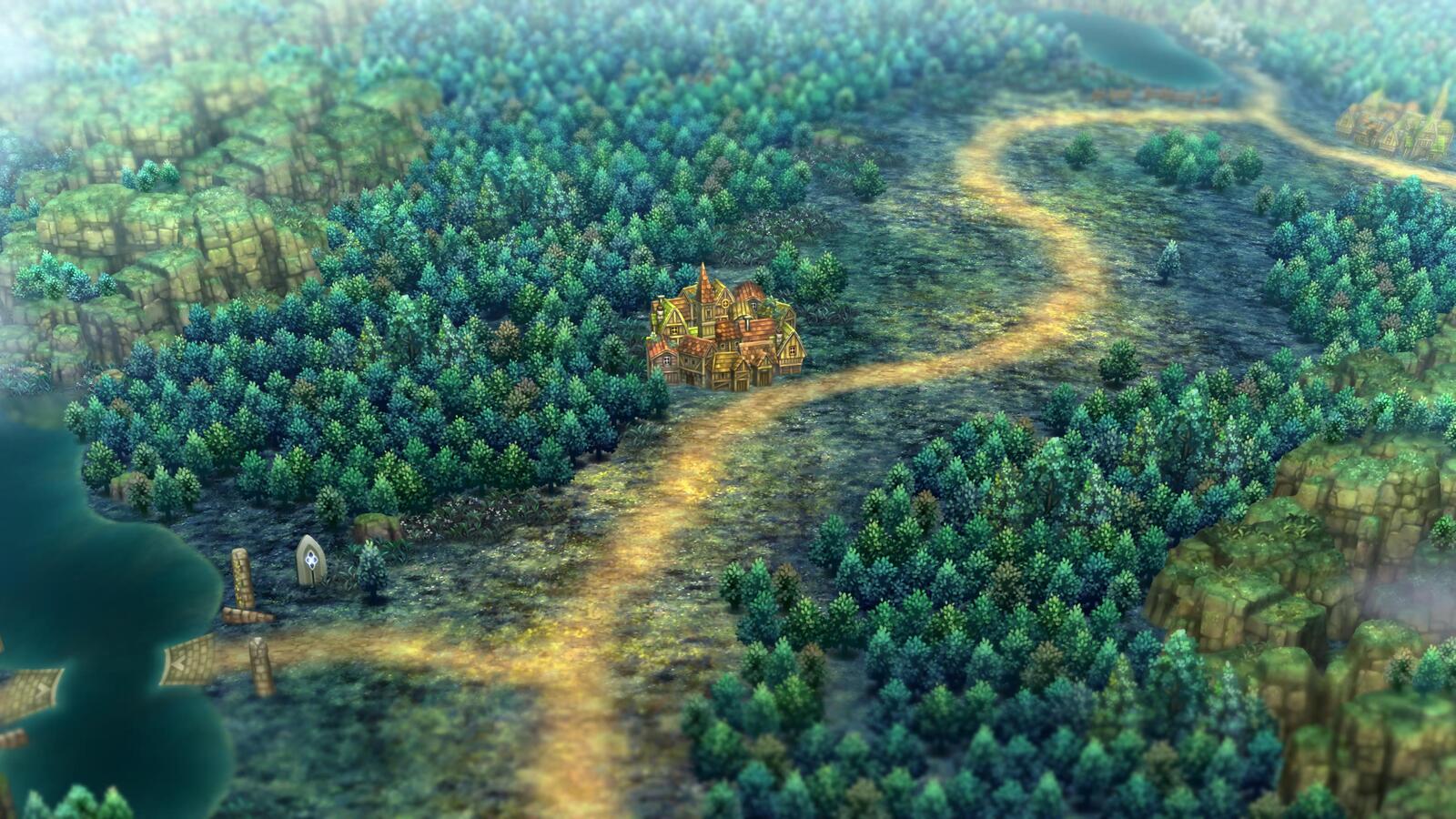
Overall
Vanillaware’s games are distinguished by the pulsing animation within the character art. Their bodies almost breathe on screen. Combined with an amazing soundtrack, beautiful maps, well designed game mechanics, and fine attention to detail, Unicon Overlord is a compelling game that can easily draw a player into its addictive tactical combat.
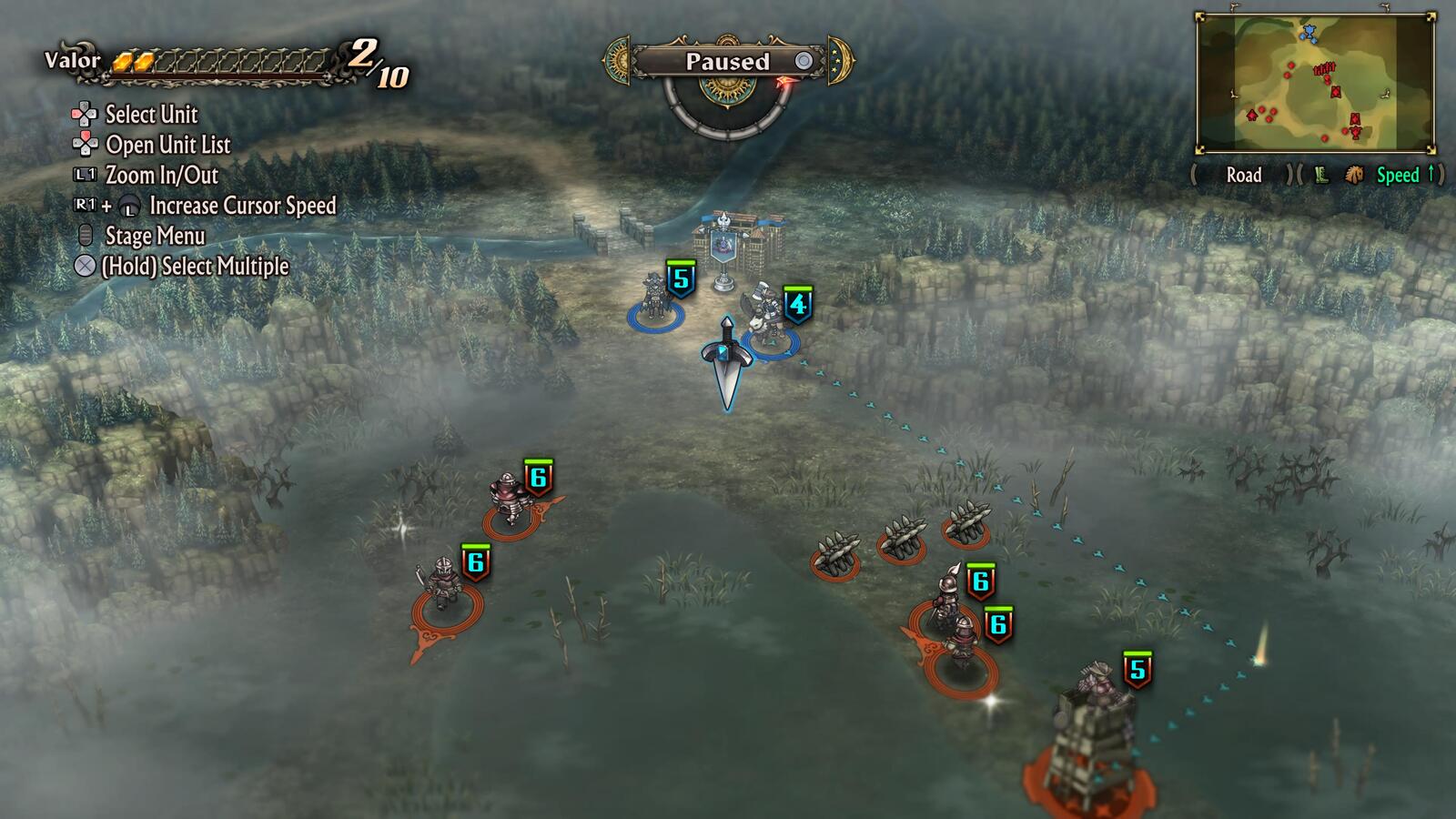
The world has some amazing depth and lore, but it also suffers from character bloat and uninteresting conversations. It could be due to translations and localization, or it may have not been a priority for the designers. If anything, Unicorn Overlord shows the value of solid game mechanics. The dialog isn’t terrible. It’s just okay. But there are a lot of characters to keep track of, and their story is not what really carries the game.
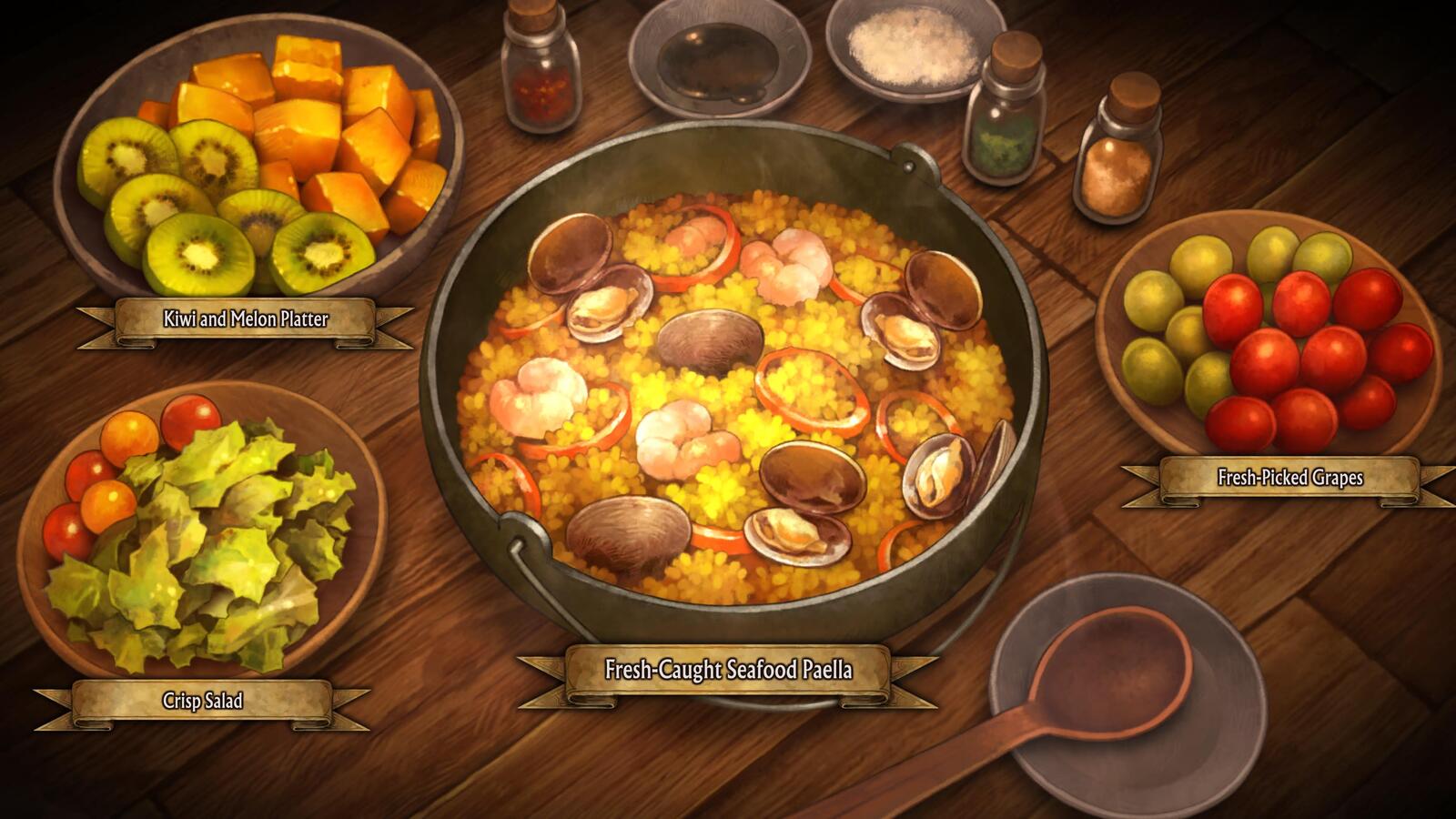
The combat mechanics are unique, and might be awkward for some. I found that the difficulty curve climbed at about the right rate. There are a few frustrating stages, but most of them can be beaten by adjusting tactics as opposed to grinding and leveling up. It’s a game that forces the player to strictly define the strategies they use prior to battle. In other games, players often do the same thing, but actively without really thinking about those decisions.
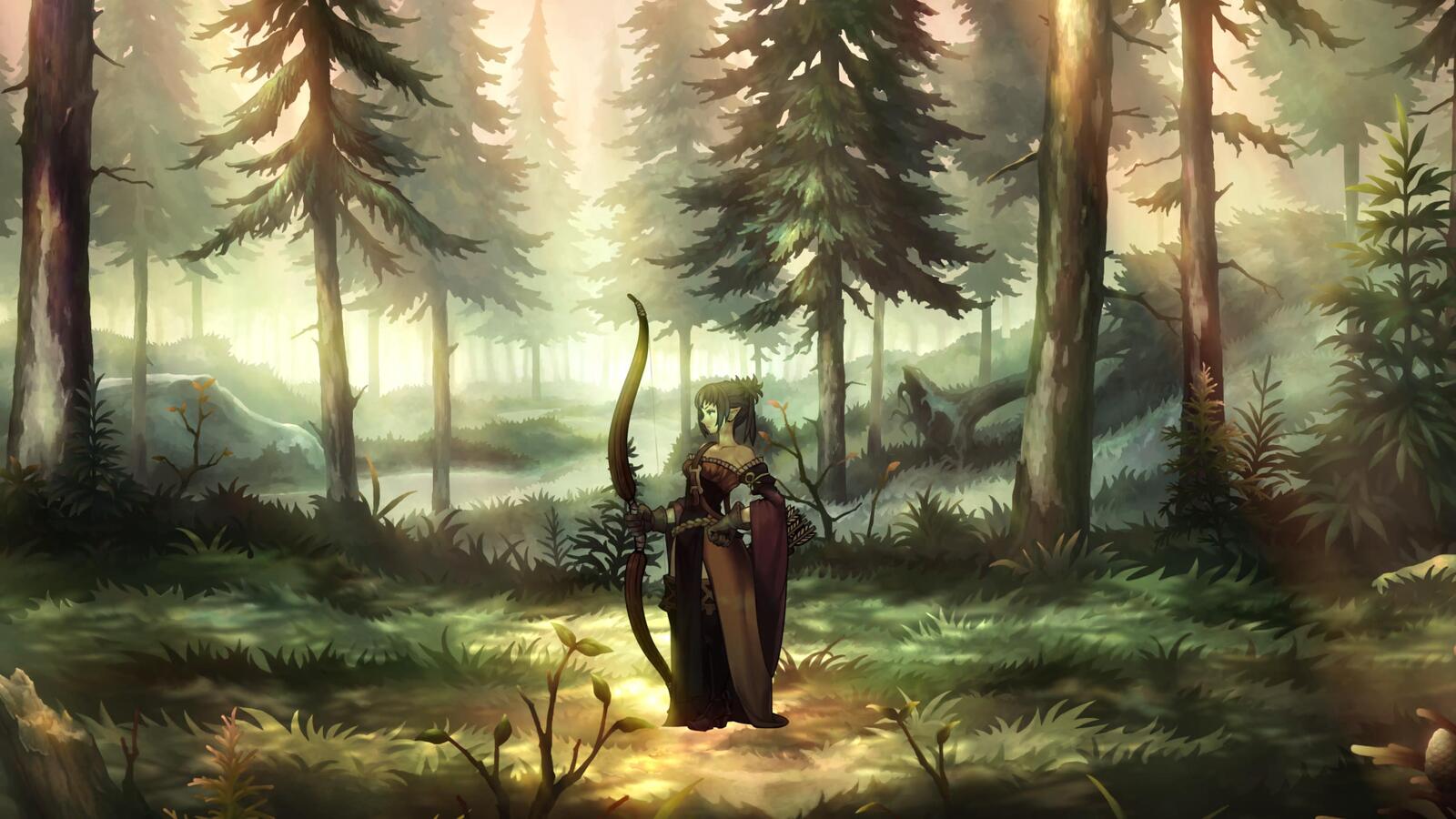
I completed all the side quests, nearly all the auxiliaries and several other missions, clocking in at 75 hours over the course of two weeks. It’s one of the few games I’m glad I pre-purchased for release day. It’s a great fantasy adventure, filled with stunning art, music and details, although it might be too addictive for its own good.
Spring Game Reviews
I’m glad I finished Xenoblade Chronicles. I wanted to finally tear into it in with a review, but I was surprised with the direction the story eventually took. By finishing this season of games with Unicorn Overlord, I learned how a really great game doesn’t always need an amazing story. However, even an amazing story can be totally ruined by the mechanics of a terrible game.
Eternighs was a fun and short filler I was surprised I found myself enjoying. I was specifically looking for a shorter game I could get through before Unicorn Overlord was released. While it’s nothing exceptional, it was engaging. Getting a Vita again opens up the world of other short games. I found Senran Kagura Shinovi Versus rather hilarious, despite it being the most basic fan service game out there.
As the weather gets warmer, I hope I can draw myself away from gaming for the coming months. I’ve found myself playing some rather long games lately, requiring significant time investments. With my PS Vita, I hope to start reviewing some games I’ve played previously on its smaller portable format, as well as less time intensive independent games.

-
PS Vita + 4 Games + $60 PSOnline. September 2013. TradeMe. ↩
-
Hot take, Casual mode is the best way to play Xenoblade definitive edition. 1 July 2020. u/gaiden_ninja. Reddit. ↩
-
This is why people hate Localizers. 17 December 2023. Hero Hei. ↩
-
Terrible news for corrupt people in Anime and Gaming. Hero Hei. 14 January 2024. ↩
-
So, it Begins. 23 December 2023. Hero Hei. ↩
-
Unicorn Overlord had a free demo released. After playing it, I can say quite confidently that the localisation is abhorrent. Here begins a thread of numerous examples.. 25 Feburary 2024. @zakogdo Archive ↩ ↩2